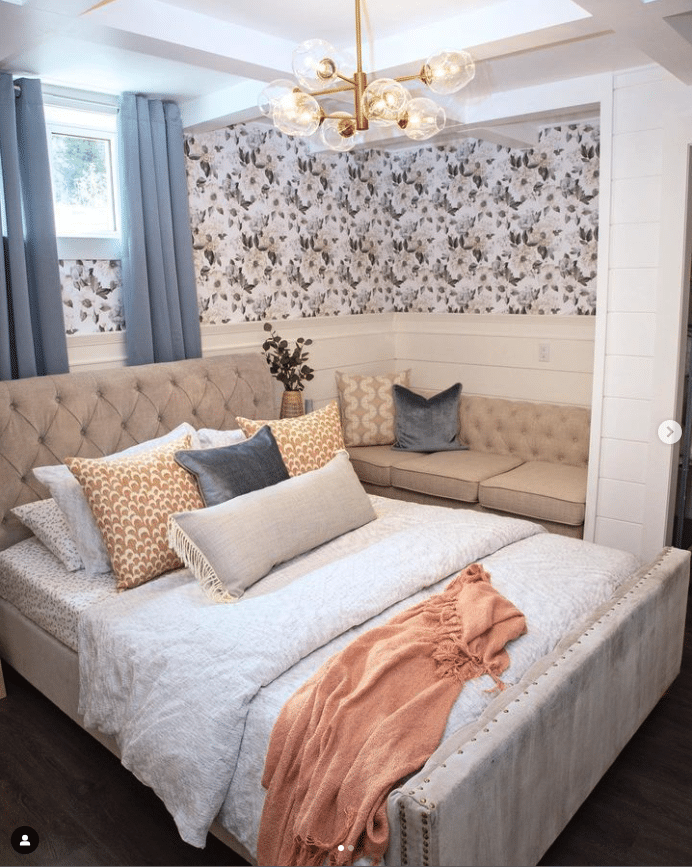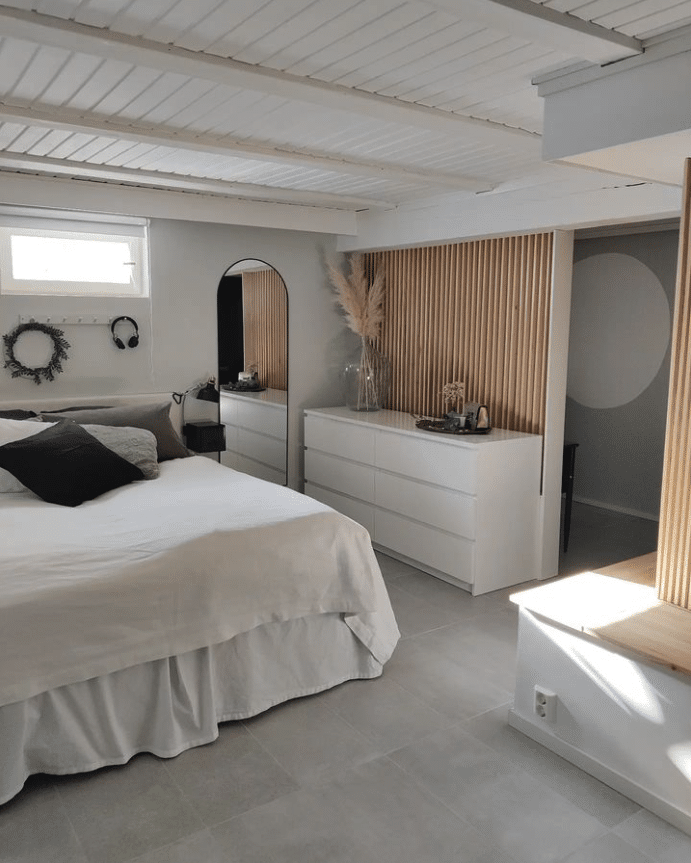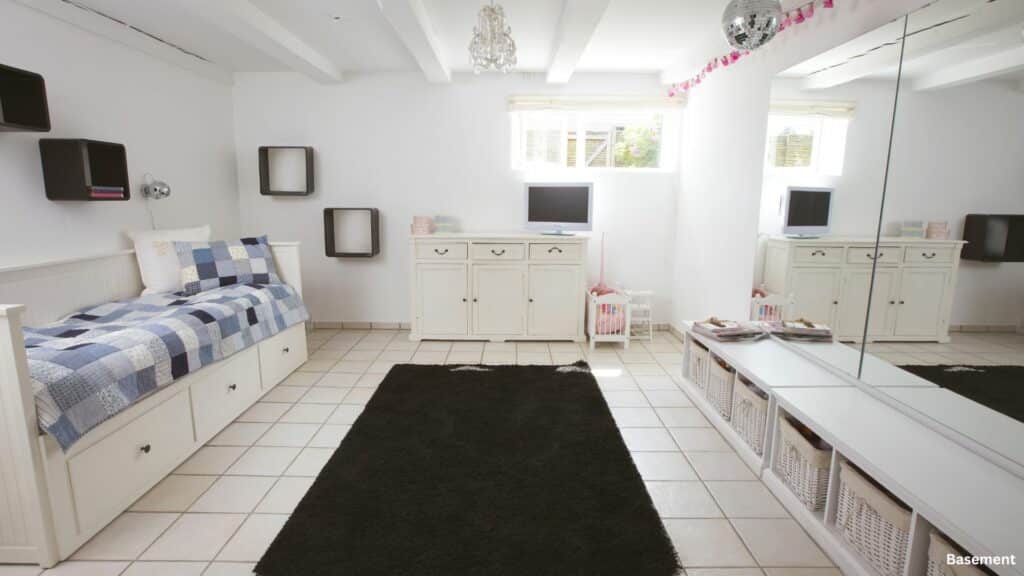A basement bedroom can be a cozy retreat, offering extra space while increasing your home’s value. However, when adding a sleeping area in your basement, it’s essential to adhere to legal requirements and incorporate thoughtful design ideas to ensure it’s a comfortable and safe living space.
Egress Window Regulations and Safety Considerations for Basement Bedrooms

Egress Window Basics:
- Egress windows provide a safe exit during emergencies.
- Every basement bedroom must have an egress window meeting specific size and clearance requirements.
- The minimum opening width is 20 inches, height 24 inches, and the net clear opening should be at least 5.7 square feet.
Placement and Accessibility:
- Install the egress window where it’s easily accessible from inside the bedroom.
- Ensure the window well is clear of obstructions and includes a ladder for easy exit.
- Place window wells that are at least 9 square feet to offer sufficient room for escape.
Additional Safety Features:
- Install smoke and carbon monoxide detectors inside or near the basement bedroom.
- Equip egress windows with sturdy but easy-to-open locking mechanisms.
Innovative Layout and Design Ideas for a Bright, Comfortable Basement Bedroom

-
Maximizing Natural Light:
- Position the basement bedroom near larger windows for optimal natural light.
- Use light-colored walls, mirrors, and strategic lighting to brighten the room.
- Avoid heavy curtains and opt for sheer blinds to maintain light flow.
-
Smart Layouts:
- Keep the bed away from windows to prevent blocking emergency exits.
- Integrate storage solutions like under-bed drawers or built-in closets.
- Create a cozy reading nook or workspace for a multifunctional basement bedroom.
-
Creative Design Elements:
- Add plants or artwork to inject personality and warmth.
- Incorporate textured throws, cushions, and rugs to enhance comfort.
- Use contrasting paint colors or wallpaper to create focal points.
Design Ideas





Choosing the Right Flooring and Finishes for a Cozy, Durable Basement Bedroom
-
Durable Flooring Options:
- Luxury Vinyl Plank (LVP): Moisture-resistant and mimics the look of hardwood.
- Laminate Flooring: Offers durability with easy installation and a variety of styles.
- Carpeting: Provides warmth and comfort but requires moisture-proof underlay.
-
Finishes and Paint:
- Opt for moisture-resistant paint finishes, such as semi-gloss or satin.
- Consider wainscoting or waterproof wall panels for added protection.
- Install baseboard trim to prevent water damage and add a polished look.
-
Insulation and Ventilation:
- Insulate walls and floors properly to maintain a stable temperature.
- Ensure sufficient ventilation with a high-quality HVAC system or dehumidifier.
Cost of Building a Basement Bedroom
Creating a basement bedroom can significantly boost your home’s value, but it’s important to consider the costs involved. Here’s a breakdown of the typical expenses you can expect:
Basic Remodeling Costs:
- Framing and Drywall: Constructing walls and adding drywall can cost between $1,000 and $2,500.
- Electrical Work: Installing lighting fixtures, outlets, and wiring averages $500 to $1,500.
- Insulation and Ventilation: Proper insulation and adding ventilation systems can range from $800 to $2,000.
Egress Window Installation:
- Window and Well Costs: An egress window installation, including the well and ladder, costs between $2,500 and $5,000.
- Excavation and Labor: Additional excavation and installation labor add $1,000 to $2,000.
Flooring and Finishes:
- Flooring: Luxury vinyl plank, laminate, or carpet installation ranges from $2 to $5 per square foot.
- Paint and Wall Finishes: Waterproof paint and wall paneling can cost $500 to $1,500.
- Baseboard and Trim: Adding baseboards and trim for a polished finish averages $200 to $800.
Additional Features:
- Closets and Storage Solutions: Built-in closets and under-bed storage may cost $1,000 to $3,000.
- Lighting Fixtures: Installing recessed lighting or bedside lamps can range from $200 to $1,000.
- Furniture and Decor: Furnishing and decorating a basement bedroom can add another $1,000 to $5,000.
Permits and Inspections:
- Permits: Depending on local regulations, building permits can range from $200 to $1,000.
- Inspections: Inspections for electrical, plumbing, and safety requirements may cost $100 to $500.
Total Estimated Costs
- Basic Basement Bedroom: $10,000 to $15,000
- Mid-Range Basement Bedroom: $15,000 to $25,000
- Luxury Basement Bedroom: $25,000 and up
Costs can vary significantly based on location, scope, and the contractor you choose. Ensure you budget for basement finishing essentials and unexpected expenses. For accurate estimates, consult with local contractors and obtain multiple quotes.

Frequently Asked Questions
Is it safe to have a bedroom in the basement?
Yes, a basement bedroom is safe if it meets local building codes and egress window requirements.
How to style a basement bedroom?
Maximize natural light, choose cozy finishes, and incorporate smart layouts for a stylish, comfortable room.
Can all bedrooms be in the basement?
Not all basements can be converted due to building codes, lack of egress windows, or moisture issues.
Why aren’t bedrooms in basements?
Some basements lack proper egress, ventilation, or moisture control, making them unsuitable for bedrooms.
Why is there no bedroom in the basement?
The absence of egress windows, moisture control, or ventilation often prevents bedrooms in basements.
